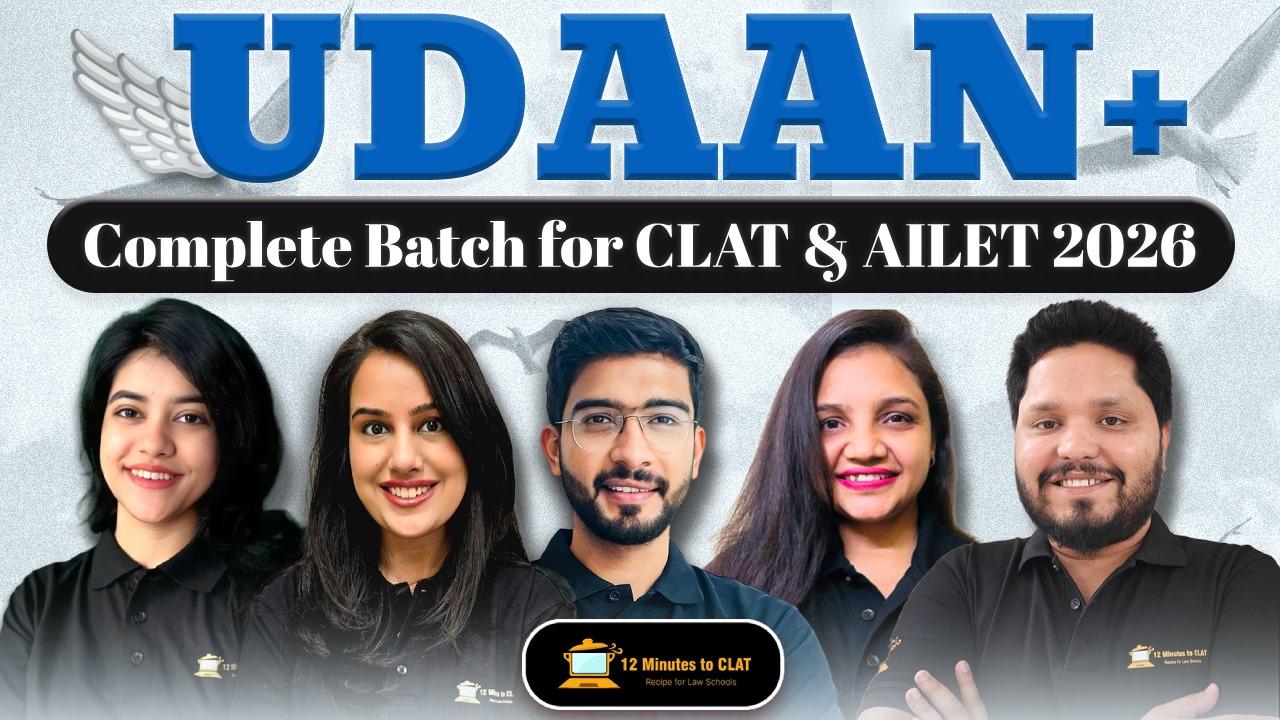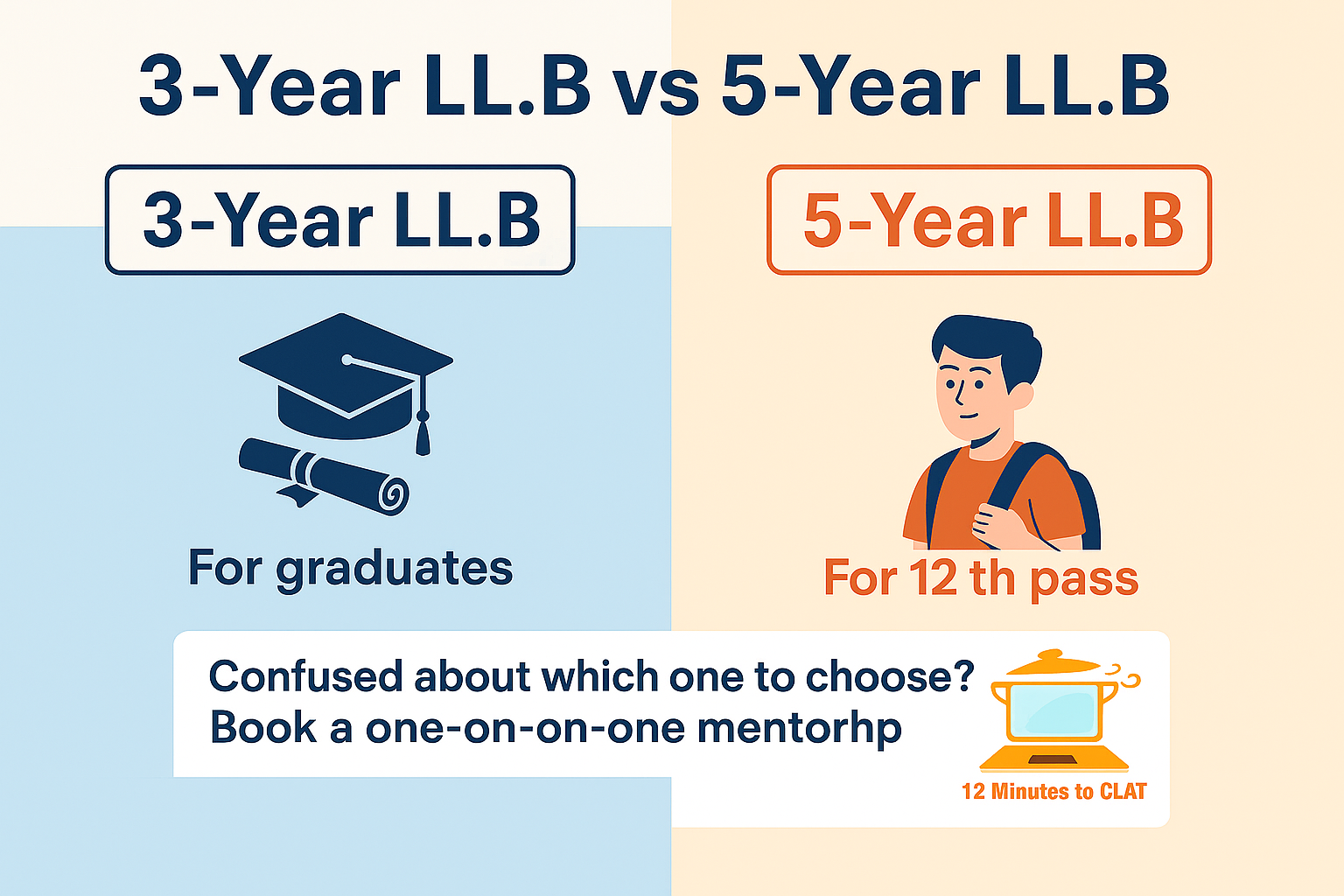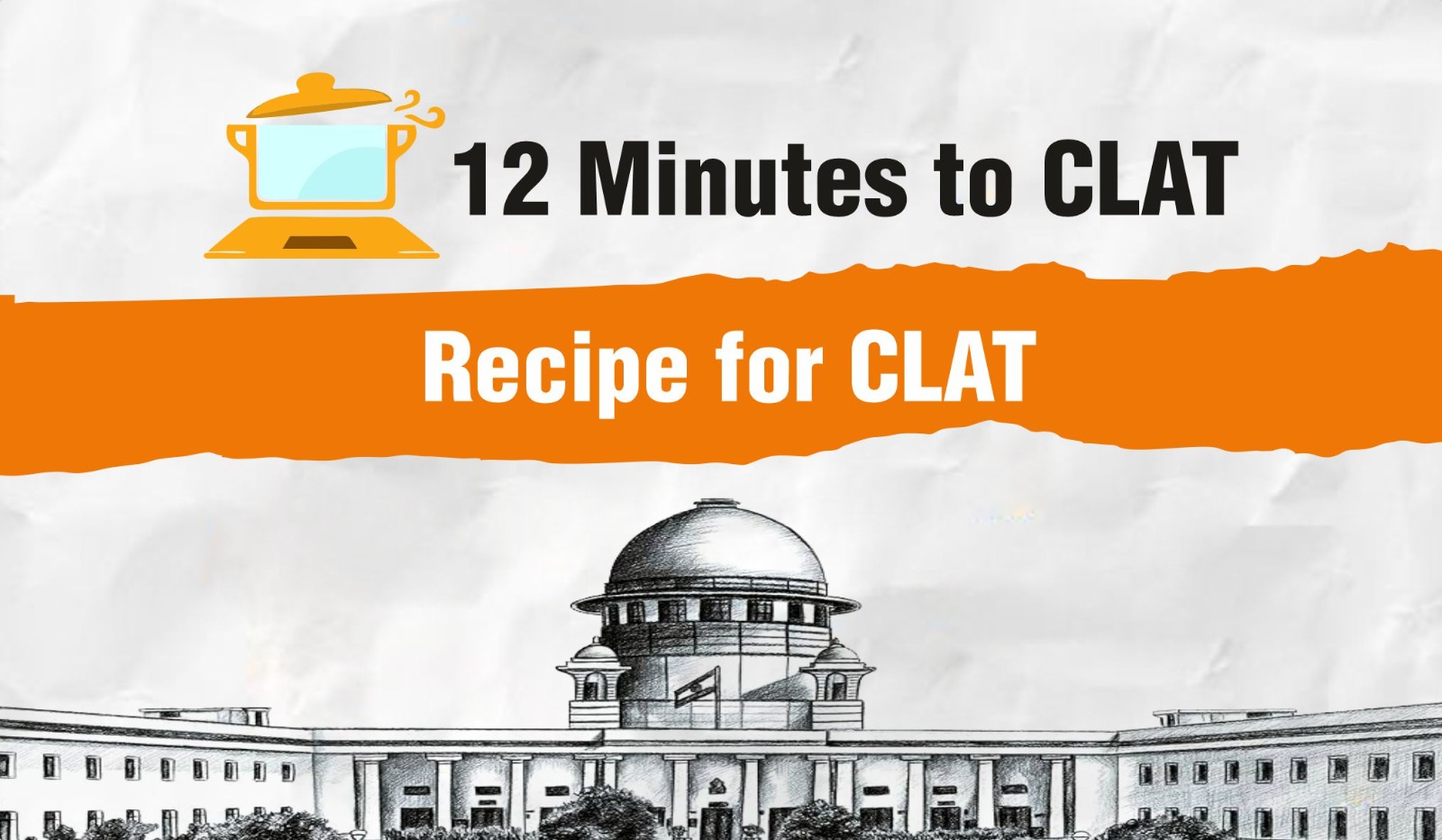CLAT 2026 – All You Need to Know
What is CLAT ?
The Common Law Admission Test or CLAT, is a national-level law entrance exam conducted by the Consortium of National Law Universities (NLUs). It is conducted to admit aspiring lawyers for undergraduate courses at 27 participating National Law Universities (NLU). Every year, over 80,000 candidates take the CLAT exam.

Eligibility
To be eligible for CLAT, a candidate must have passed class 12th from a recognised board with at least 45% marks (40% in the case of SC / ST candidates).
CLAT 2026 Date
December 2025 (final date yet to be announced)
Pattern
CLAT is conducted in the pen-and-paper format. It is a 2-hour test, with 120 multiple-choice questions carrying 1 mark each. There is a negative marking of 0.25 marks for every wrong answer. The questions are divided into 5 subjects with each subject carrying the number of questions and weightage as given below:
|
Subject |
No. of Questions |
Weightage |
|
English Language |
22-26 questions |
Roughly 20% |
|
Current Affairs, including General Knowledge |
28-32 questions |
Roughly 25% |
|
Legal Reasoning |
28-32 questions |
Roughly 25% |
|
Logical Reasoning |
22-26 questions |
Roughly 20% |
|
Quantitative Techniques |
10-14 questions |
Roughly 10% |
Subject – Wise Analysis of CLAT
- ENGLISH LANGUAGE
Relevance
This section in CLAT is designed to evaluate a student's Reading and Comprehension abilities. The legal profession necessitates rapid assimilation of information and a deep understanding of complex texts. Furthermore, a robust vocabulary empowers lawyers to articulate their arguments succinctly and effectively.
Pattern:
This section consists of passages of about 450 words, each followed by 5 questions that are to be answered in the context of the passage. The passages are derived from contemporary or historically significant fiction and non-fiction writing. Students have to read the passages and answer the underlying questions accordingly.
Concepts to be studied
Reading Comprehension: Deriving the main idea and conclusion of a passage; tone of a passage; appropriate title of a passage; appropriate source of a passage; appropriate theme of a passage; making deductions, inferences, and drawing conclusions from the passage; understanding opinions expressed in the passage; summarizing the passage or a portion of the passage; vocabulary, synonyms, antonyms, Idioms & Phrases.
English Grammar: Parts of Speech, Figures of Speech, Tenses, Adjectives, Adverbs, Para-Jumbles, sentence correction, Active & Passive Voice, sentence rearrangement.
Sources to Prepare
- Regular newspaper reading for developing reading speed and comprehension skills along with vocabulary.
- Books- Word Power Made Easy, Wren & Martin, 30 days to a More Powerful Vocabulary, Objective General English by RS Aggarwal.
- Practicing sectional tests and mock tests.
- GENERAL KNOWLEDGE & CURRENT AFFAIRS
Relevance
This section evaluates candidates' understanding of contemporary issues and their fundamental general knowledge. Lord Brougham stated that “A Lawyer should know something about everything and everything about something”. A Legal Professional is required to be industrious and keep himself updated in the evolving world. This section tests the ability of aspiring lawyers to consistently work on themselves by updating their knowledge and keeping up with the changing dynamics of the world.
Pattern
This section in CLAT consists of passages of about 250-350 words, each followed by 5-7 questions per passage that are to be answered in the context of the passage. The passages will be derived from news, journalistic sources, and other non-fiction writing. Candidates often tend to skip reading the passages in this section. However, considering the pattern in the past few years, the candidates are advised to read the passages as the answers to some questions can be possibly derived from the passage itself.
Syllabus
National Current Affairs, International Current Affairs, Legal Current Affairs, Reports & Indices, Important Space Missions, Current Affairs related to Defence including important military exercises, Government Schemes, Sports Current Affairs, Awards & Honours, Summits & Conferences, Science & Technology, Important Days, Arts and culture and Historical events of continuing significance.
Candidates are advised to have in-depth knowledge of every topic and be conversant with everything that can be possibly related to the topic.
Sources to Prepare
- Regular Newspaper Reading is very crucial for developing awareness of contemporary affairs and scoring high in this section.
- Articles, Journalistic and Non – Fictional Writings, Opinions of scholars and legal professionals on contemporary issues.
- Detailed Current Affairs updates and monthly compilations available on various online websites.
- LEGAL REASONING
Relevance
This section in CLAT aims to test the legal acumen, interpretation skills and problem-solving capacity of a candidate. This section mirrors the daily tasks of a Legal Professional, that is, to read laws and apply them to the case at hand. It is very important for a lawyer to be able to comprehend a statute and interpret it in the most accurate way possible. Therefore, this is one of the most important sections in this exam. It also acts as a tiebreaker when two candidates’ overall score is the same.
Pattern
This section in CLAT consists of passages of about 450 words, each followed by 5 questions that are to be answered in the context of the passage. The passages majorly relate to legal matters, public policy, or moral philosophical enquiries. Though the section does not require prior legal knowledge, the candidates are advised to attain a basic understanding of the major laws and legal principles and practice questions based on them.
The questions in this section are mostly fact-based scenarios in which the candidates are required to apply the legal understanding that they have derived from the principles given in the passage. The section also includes Assertion – Reasoning type questions, basic legal knowledge and conclusion-based questions.
Concepts to Prepare
Law of Torts, Law of Contracts, Constitutional Law, Criminal Law, Family Laws, Intellectual Property Laws, International Laws and conventions, Miscellaneous Laws like the Domestic Violence Act, POCSO Act, POSH Act, etc, Legal Maxims, Important Legal Principles & Doctrines, Landmark Cases.
Sources to Prepare
- Regular newspaper reading is crucial to prepare for this section in order to be aware of the legal developments happening in the country and around the world.
- Books: Legal Awareness and Legal Reasoning by A P Bhardwaj, Objective Legal Aptitude by RS Aggarwal, Legal Awareness and Legal Reasoning by A P Bhardwaj
- Practicing Sectionals Tests and Mock Tests.
- LOGICAL REASONING
Relevance
This section assesses the candidates' analytical, decision-making, and judgment skills. Lawyers frequently need to analyse complex situations and make informed decisions to best serve their clients' interests. Legal professionals also employ strategic tactics during legal proceedings, such as court arguments, to achieve favourable outcomes. These tactics necessitate prudence and discretion, which are cultivated through logical reasoning and critical thinking skills.
Pattern
This section consists of passages of about 350-450 words, each followed by 5 questions that are to be answered in the context of the passage. The passages are mostly based on non – fictional writings on contemporary issues. The questions are aimed at testing the comprehension, judgement and critical thinking skills of the candidates. It is crucial to understand the overall gist or the main idea of the passages in this section as the questions are majorly reasoning based.
Concepts to Prepare
Premise, Conclusion, Assumption, Inference, Main Idea, Strengthening, Weakening, Cause – Effect, Cause of Action, Paradox, Parallel Logic, Flaw in the reasoning, Analogies and Assertion – Reasoning questions.
Sources to Prepare
- Candidates are advised to read newspaper opinions written by legal scholars and endeavour to critically analyse them and deduce the main idea, major arguments, their premise and conclusions, identify the reasoning of the author, and draw inferences.
- Books: Verbal and Non-Verbal Reasoning by R.S. Aggarwal, Logical Reasoning by Arun Sharma, A New Approach to Verbal and Analytical Reasoning by Arihant.
- Practice Sectional Tests and Mock Tests.
- QUANTITATIVE APTITUDE
Relevance
The Quantitative Techniques section in CLAT is designed to test a candidate’s numerical ability and problem-solving skills. It aims to help the candidates build a foundation for their legal careers. Many aspects of law, including economic policies, taxation, and corporate law, require a solid understanding of quantitative concepts. Mastering the QA section can provide a strong foundation for tackling these subjects in future studies. This section also has a lot of scoring potential as it contains objective questions unlike other sections of the exam that have a scope of ambiguity.
Pattern
This section includes short sets of facts or propositions, or other textual representations of numerical information, followed by a series of questions. Candidates are required to derive information from the passages or questions and apply mathematical operations to such information. The information in the passage is mostly in the form of Bar Graphs, Pie Charts, Venn Diagrams, Line Graphs, Tables, and Histograms. Students are also required to learn tricks to perform faster calculations.
Concepts to Prepare
Percentage; Ratio and Proportions; Permutation and Combination; Probability; Time, Speed and Distance; Averages; Time and Work; Mensuration; Profit, Loss and Discount; Simple Interest and Compound Interest.
Sources to Prepare
- Books: Data Interpretation by R.S Aggarwal, Elementary Mathematics with Numerical Ability by Prateek Jain, Magical Book on Quicker Maths by M Tyra and Quantitative Aptitude by R.S Aggarwal.
- Practice Sectional Tests and Mock Tests.
Why CLAT ?
CLAT is a national-level law entrance examination, holds the responsibility of filtering out the most promising candidates for legal education who are capable of contributing to and developing the legal functionary of the country.
By assessing a candidate's aptitude for critical thinking, analytical reasoning, and legal acumen, CLAT seeks to identify individuals who possess the essential qualities of a successful lawyer. These qualities include discipline, consistency, patience, and prudence. Candidates who cultivate these virtues during their preparation are more likely to excel in the examination and secure admission to prestigious NLUs
Top NLUs to target:
- NLSIU or NLS Bangalore;
- NALSAR Hyderabad;
- NLU Jodhpur;
- NUJS Kolkata;
- GNLU Gandhinagar;
- NLIU Bhopal;
- HNLU Raipur;
- RMLNLU Lucknow;
- NLU Odisha;
- RGNUL Patiala.
For any queries regarding CLAT Coaching, reach out to us at +91-9303019139 or +91-9929774737 or visit 12minutestoclat.com











